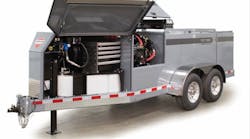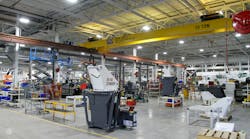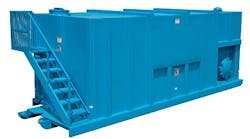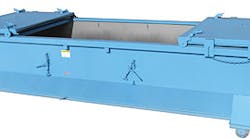LIFE as they know it in central New York is about to change dramatically. Gov Mario Cuomo is expected later this year to lift the state's moratorium on hydraulic fracturing (or hydrofracking), which would open up New York to natural gas drilling in the Marcellus Shale and Utica Shale geological formations.
Life at STS Truck Equipment has already changed. The transformation started in 2009 and intensified in 2010 as hydrofracking in Pennsylvania mushroomed and injected a much-needed boost into the state's downtrodden economy.
STS, which is based in Syracuse and has offices in Buffalo, Rochester, and Albany, formed alliances with companies in Pennsylvania and watched as its business increased $750,000 in 2010 directly related to equipment for the hydrofracking industry, according to president Steve Jacobs. Based on the first seven months of this year, Jacobs expects a boost of $2-3 million.
With drilling expected to start in New York in January, Jacobs is projecting a $10-million boost in 2012 just for equipment alone — not including service, which will experience a significant change.
“We were doing nothing in that industry before,” Jacobs says. “When you're looking at a specific industry that is going to have a large effect on the sales growth of STS, it is a very exciting time. We have been told that each well site may have four wells on it. But each platform may require anywhere up to 25 tank trailers to support it. I think there were a few hundred wells started in 2009 in Pennsylvania and over 2000 in 2010. So you can do the math. The amount of potential trailers — just tanks alone — to support that is huge. Can we grasp it? Not really, because the potential depends on how many permits are given for the different sites. It could explode very quickly. That's why we have so much equipment on order, gearing up for it.
“For us, it is huge, not only because we supply the fracking end with tank trailers that haul sand, sludge, and water, and the same thing for bodies, but we're also servicing people that are now related to service businesses. Whether it's van bodies, service bodies, dump bodies, it's growing because people will be building new homes and hotels. A lot of people are moving in. It has that ripple effect all the way down.”
STS has aligned with manufacturing partners such as Deist industries, which is based in Hadley, Pennsylvania, and owns Bucks Fabricating. Deist supplies STS with tanks that are mounted on bodies, roll-off tanks, and products to haul everything from mud, water, and sludge. MAC Trailer is supplying STS with tanks for the water and sand that is used in fracking.
“MAC Trailer is seeing a huge increase,” Jacobs says. “They got into the tank business in the last two years, primarily because of this demand. There wasn't capability to fill the demand for this product. I have 15 tanks on order right now for the remainder of this year and 60 for 2012. That's a $5-million investment just in tanks on order.
“The new thing for us is to be in the tank business. We have realized tremendous growth coming from nothing. Tanks are doing great all way to Texas, where you have hydrofracking going on, to South Dakota and Pennsylvania.
The business involves far more than selling tanks, Jacobs says.
“Let's say you have a well in the middle of a small forest. You have to get access to it. We supply equipment such as Echo chainsaws all way down to the dump bodies and trailers that will be used in making the roads and then used to make the platform where the well is. Then everything from frack tanks to water tanks and storage tanks they use when the well is in. We have positioned our company to go from start to finish in working directly with these fracking companies.”
Harvesting Shale areas
At an estimated 95,000 square miles, the Marcellus Shale is the world's second-largest natural gas field. It runs to a depth of 7000 feet across the Southern Tier and Finger Lakes regions of New York, down through northern and western Pennsylvania, eastern Ohio, western Maryland, and most of West Virginia, extending across the state line into far western Virginia. There are estimates of recoverable reserves of at least 489 trillion cubic feet. The Utica Shale exists about 2000 feet below the Marcellus, and lies beneath parts of Kentucky, Maryland, New York, Ohio, Pennsylvania, Tennessee, West Virginia and Virginia, as well as Lake Ontario, Lake Erie and a section of Ontario, Canada. It is believed to have reserves that exceed those of the Marcellus.
To harvest these areas, companies use a combination of horizontal drilling and hydrofracking, which involves pumping a mixture of water, sand and chemicals down the well under high pressure to create fractures in the gas-bearing rock. The fractures are held open by the propping material, and additional gas is then able to escape into the well. Fracking fluid is 99% water and contains small amounts of chemical additives including friction reducers, bactericides, and emulsion elements.
Deist Industries president Matt Wilson said his company distributes almost all of its product lines to STS, including the AmeriDeck loading system, which can lift up to 2500 pounds of equipment or materials into the back of a pickup truck. It essentially serves the same purpose as a utility trailer, minus insurance costs and registration fees. It can be installed on any standard 8-foot or 6½-foot bed, as well as many service bodies.
“These surveying companies typically go out in rough areas and tight spaces,” Wilson says. “They can't take a trailer. They typically would be loading and unloading ATVs for hundreds of acres, getting ready to do testing. They set up and find out where the sweet spots in shale are, and they clear off a path. When they drill, they essentially have a completely flat surface and will lay down plastic to prevent any part of the process from getting onto the soil. They put aggregate down holes with drill bits to speed up the process.”
The Bucks Fabricating manufactures products for this application. The company's Mud Box is equipped with a 4” tow bar, allowing the box to be dragged around the job site on its skid-like base. Mud Boxes are used for mixing different slurries to solidification by adding a denser matter (usually lime or mulch). This process is completed at the drilling site or at a separate treatment site.
Rolling Roof Boxes are completely sealed containers with large sliding lids and wide openings for containing and transporting contaminated soil, sludge, drill turnings and other mixed solids. These solids are transported to a treatment site or directly to an approved disposal site.
Vacuum Boxes will safely transport and store hazardous and nonhazardous (wet or dry) materials such as oils, sludge, chemicals, liquid waste, slurry, fly ash, mud, drill turnings, and other environmentally harmful materials. On drilling sites, Bucks Fabricating Vacuum Boxes are used to clean out Frac tanks and then transport the mixed materials to treatment and disposal sites.
Metering skids are used in both the oil and gas industries in the production phase of a well. Built specifically for each site, these skids are located near a wellhead and outfitted with various measurement and communication devices that track the gas throughput from the well to the transportation lines.
Wilson said Deist experienced a 60% increase in sales last year, and through July was 89% above last year. As of July, it added 27 production employees.
“We went from working one line in each of our facilities to working three in one and two in another,” he says. “The hydrofracking industry has greatly impacted us. We had big blip in 2008, and we worked to find other markets we could work well in. We had worked in the fringes of this market before, selling products into Texas, Oklahoma, and Arkansas. Right about that time, fracking started opening up in Pennsylvania, so we intensified our marketing and sales efforts into those areas. Likewise, things really teed up to go well in New York state, and we looked for a company we could partner with that had a lot of our same values as far as service and sales. Through years of knowing the guys at STS and knowing how many service people they have and how important that is in this industry, we thought it was an ideal fit to move forward and strengthen our relationship with them.”
Jacobs is forecasting a massive boom on the service side. All four of his locations are equipped with service vehicles, but the Syracuse and Rochester stores will be most affected because they are near the largest concentration of the work presently being done in the Marcellus Shale.
STS is currently running one truck in each location, but will add one or two additional trucks in Syracuse and Rochester just to support the hydrofracking industry.
“They want us to come to them more than they want to bring equipment to us,” Jacobs says. “We provide 24/7 service and these people run a 24/7 operation. If they have problems with equipment and wells are down, it's a real problem for them.”
Marketing tools added
Jacobs says STS is launching a marketing effort to deal directly with this industry. STS has purchased numerous domain names — including frackingtimes.com (which will include an informational blog and industry newsletter), frackingequipment.com, fracktank.com, hydraulicfracturingequipment.com, hydrofrackingequipment.com, and marcellus-shale.com.
“We are putting direct landing pages for somebody Googling ‘New York fracking equipment,’” he says. “If they Google that, it will come up and they will land on our landing page, which will give them information where they can be directed to. We are trying to help a lot of these people that don't know where to get the equipment to gather the information very quickly.”
Not everybody is excited about the imminent lifting of the moratorium — dissenters are upset about drill-site explosions, spillage of production liquids, and tainted water supplies — but New York has been pushing for it.
In Drilling for Jobs: What the Marcellus Shale could mean for New York, The Public Policy Institute of New York State Inc reported that 48,000 private-sector jobs in Marcellus Shale-related sectors were created in 2010 in Pennsylvania. It estimated that with 500 new wells being started every year in a five-county area of New York, 37,572 new jobs could be created each year, paying an average salary of $79,184 — over double the average private-sector wage upstate.
A recent study indicates that the total economic impact, by value added, of Marcellus Shale-related industries in Pennsylvania was $3.87 billion in 2009 alone, and that Marcellus natural gas producers in Pennsylvania planned to spend over $8.7 billion in 2010.
A total of 2851 wells were drilled in Pennsylvania in 2010, approximately half of them in the Marcellus Shale. New York is expecting much of the same in the future.
“When you look at those numbers, the potential economic explosion is just tremendous,” Jacobs says. “We believe we will be able to meet the demand when New York starts up. It's a little bit of a gamble. How many permits and wells will be drilled? Permits have not been issued. By all indication of all government agencies, permits are going to be issued after a 90-day period ends October 1, and that will give us an indication of what will be needed.”
STS might take on a whole new meaning: Stands To Soar.










